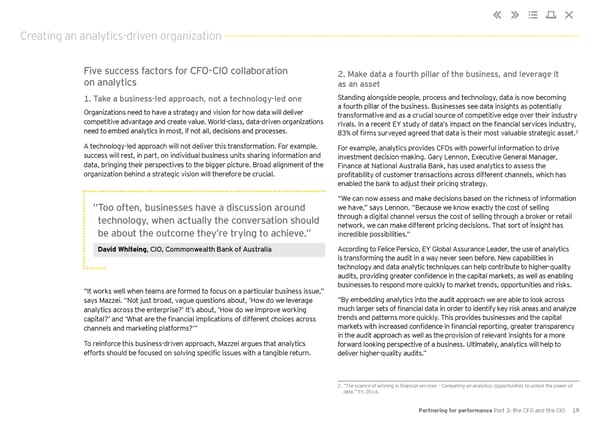Creating an analytics-driven organization Five success factors for CFO-CIO collaboration 2. Make data a fourth pillar of the business, and leverage it on analytics as an asset 1. Take a business-led approach, not a technology-led one Standing alongside people, process and technology, data is now becoming Organizations need to have a strategy and vision for how data will deliver a fourth pillar of the business. Businesses see data insights as potentially competitive advantage and create value. World-class, data-driven organizations transformative and as a crucial source of competitive edge over their industry rivals. In a recent EY study of data’s impact on the financial services industry, need to embed analytics in most, if not all, decisions and processes. 2 83% of firms surveyed agreed that data is their most valuable strategic asset. A technology-led approach will not deliver this transformation. For example, For example, analytics provides CFOs with powerful information to drive success will rest, in part, on individual business units sharing information and investment decision-making. Gary Lennon, Executive General Manager, data, bringing their perspectives to the bigger picture. Broad alignment of the Finance at National Australia Bank, has used analytics to assess the organization behind a strategic vision will therefore be crucial. profitability of customer transactions across different channels, which has enabled the bank to adjust their pricing strategy. “We can now assess and make decisions based on the richness of information “ Too often, businesses have a discussion around we have,” says Lennon. “Because we know exactly the cost of selling technology, when actually the conversation should through a digital channel versus the cost of selling through a broker or retail be about the outcome they’re trying to achieve.” network, we can make different pricing decisions. That sort of insight has incredible possibilities.” David Whiteing, CIO, Commonwealth Bank of Australia According to Felice Persico, EY Global Assurance Leader, the use of analytics is transforming the audit in a way never seen before. New capabilities in technology and data analytic techniques can help contribute to higher-quality audits, providing greater confidence in the capital markets, as well as enabling “It works well when teams are formed to focus on a particular business issue,” businesses to respond more quickly to market trends, opportunities and risks. says Mazzei. “Not just broad, vague questions about, ‘How do we leverage “By embedding analytics into the audit approach we are able to look across analytics across the enterprise?’ It’s about, ‘How do we improve working much larger sets of financial data in order to identify key risk areas and analyze capital?’ and ‘What are the financial implications of different choices across trends and patterns more quickly. This provides businesses and the capital channels and marketing platforms?’” markets with increased confidence in financial reporting, greater transparency in the audit approach as well as the provision of relevant insights for a more To reinforce this business-driven approach, Mazzei argues that analytics forward looking perspective of a business. Ultimately, analytics will help to efforts should be focused on solving specific issues with a tangible return. deliver higher-quality audits.” 2. “The science of winning in financial services — Competing on analytics: Opportunities to unlock the power of data,” EY, 2014. Partnering for performance Part 3: the CFO and the CIO 19
 Partnering for Performance Part 3 Page 18 Page 20
Partnering for Performance Part 3 Page 18 Page 20